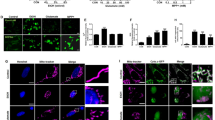Abstract.
The effects of two toxins, sodium cyanide (NaCN) and ionomycin (IM), on neuronal viability and on the expression of the microtubule-associated proteins MAP1, MAP2, and tau were studied in isolated chick cortical neurons. Cytotoxic hypoxia due to NaCN treatment was performed to mimic acute neuronal damage, whereas long-term IM treatment was used as a model for chronic neuronal impairment. After 5 days in vitro, a cytotoxic lesion was induced either by addition of NaCN (0.01–10 mM) or IM (0.01–10 µM). The NaCN solution was aspirated after 30 min and cells were allowed to regenerate for 6 h, 24 h, 48 h, or 72 h; whereas the permanent IM lesions were left undisturbed during the same periods of time. Neuronal viability was assessed by MTT assay. The abundance of MAP1, MAP2, and tau was evaluated by immunoblotting and, for MAP2, by immunohistochemistry also. Results showed that NaCN and IM lesions dose-dependently decreased viability. Irreversible cell damage occurred after impairment with 10 mM NaCN and 1 µm or 10 µm IM, while neurons lesioned with lower concentrations regenerated partially or adapted to the toxic environment. However, the same level of viability as of untreated cells was never reached. Furthermore abundance of MAPs was changed after both lesions. But while after extended recovery from NaCN lesion protein expression was normalizing (MAP2) or at least still detectable (MAP1A, tau), the consequences of a permanent IM lesion were more severe, since neurons were not able to maintain or even restore their MAP expression. Immunohistochemical experiments for MAP2 revealed that, compared with controls, NaCN and, to a much higher extent, IM treatment resulted in a loss of immunoreactivity in neurites due to progressing cell death.
Similar content being viewed by others
Author information
Authors and Affiliations
Additional information
Electronic Publication
Rights and permissions
About this article
Cite this article
Hutter-Paier, B., Grygar, E., Loibner, M. et al. Effects of NaCN and ionomycin on neuronal viability and on the abundance of microtubule-associated proteins MAP1, MAP2, and tau in isolated chick cortical neurons. Cell Tissue Res 302, 39–47 (2000). https://doi.org/10.1007/s004410000258
Received:
Accepted:
Issue Date:
DOI: https://doi.org/10.1007/s004410000258




